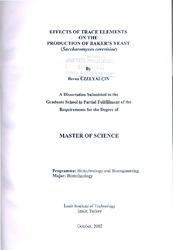Please use this identifier to cite or link to this item:
https://hdl.handle.net/11147/3694Full metadata record
| DC Field | Value | Language |
|---|---|---|
| dc.contributor.advisor | Harsa, Hayriye Şebnem | - |
| dc.contributor.author | Üzelyalçın, Berna | - |
| dc.date.accessioned | 2014-07-22T13:52:10Z | - |
| dc.date.available | 2014-07-22T13:52:10Z | - |
| dc.date.issued | 2002 | - |
| dc.identifier.uri | http://hdl.handle.net/11147/3694 | - |
| dc.description | Thesis (Master)--İzmir Institute of Technology, Biotechnology and Bioengineering, İzmir, 2002 | en_US |
| dc.description | Includes bibliographical references (leaves: 83-85) | en_US |
| dc.description | Text in English;Abstract: Turkish and English | en_US |
| dc.description | ix, 85 leaves | en_US |
| dc.description.abstract | Baker.s yeast has been used widely in traditional bakeries to produce different kinds of baked products and for many biotechnological purposes. The principal raw materials used in producing baker.s yeast are the pure yeast culture and molasses. Cane molasses and beet molasses contain 45 to 55 % sugar in the forms of sucrose, glucose, and fructose. Molasses, which is a rich carbon and mineral source, contains most of the nutrients and minerals required for baker.s yeast production. Nutrients and trace elements (magnesium, copper and zinc) that are not present in sufficient quantities in molasesses are added to the fermentation medium. In this study, the effects of Ca2+, Mg2+, Cu2+ and Zn2+ on baker.s yeast production were investigated. The method of Food Composition Laboratory (FCL), Human Nutrition Research Center, Beltsville, US, was used for the preparation of the fermentation samples prior to ICP-AES analysis. The concentrations of Ca2+, Mg2+, Cu2+, Zn2+ were determined in the raw materials entering the fermentors and the products. FCL digestion method was evaluated on precision and accuracy; linear standard curves were obtained for the studied concentration ranges of Ca2+, Mg2+, Cu2+ and Zn2+. Standard addition curves for each element in 45 brix molasses and dry yeast samples were constructed and spike recovery percentages were calculated. High spike recovery percentages were obtained for all elements in both dry yeast and molasses with the FCL method. In industrial fermentations, uptakes of Ca2+, Cu2+, Mg2+ and Zn2+ by the yeast cells were calculated as mg/kg dry yeast at 4h time intervals. The uptake rates were evaluated based on the available element concentration in the medium and the uptake of the elements. Results showed that, as the uptake of Ca2+ increased with time, uptake of Mg2+, Cu2+ and Zn2+ decreased. The yeast cells used the available elements with decreasing uptake rates except Ca2+. During the first hours of fermentation, uptake rates were high. The maximum uptake rates observed for each element in two different industrial fermentations were: 17.73-23.32 mg Cu2+/ kg dry yeast cells , 195.64-413.46 mg Zn2+ / kg dry yeast cells, 2106.46-2051.74 mg Mg2+ / kg dry yeast cells. Ion concentrations of biomass in industrial fermentations revealed that same amounts of Mg were taken by the cell from the fermentation medium under similar conditions. This was verified by the studies done in lab-scale using pure culture of S.cerevisiae, grown on different concentrations of Mg2+. It was found that uptake of Mg2+ was constant and very close to the uptake values of industrial fermentations. 806.7 mM Mg2+ was taken by 1 kg of dry yeast cells. This is in agreement with the stated Mg2+ uptake concentration range 500-1000 mM of Saccharomyces cerevisiae in literature. In the industry, magnesium is added in the form of Mg.SO4.7H2O to the fermentation medium. SO42- ions coming from the MgSO4.7H2O cause settling problems in the waste treatment system of the plant. Generally, molasses contain sufficient concentration of Mg2+ ions required for baker.s yeast production in the industrial scale. Since Mg2+ has toxic effects at high concentrations and its addition is increasing the cost of the process and causing difficulties in the waste treatment of the plant, it may be concluded that addition of Mg2+ as MgSO4.7H2O to the fermentation medium should be done after determining the Mg2+ concentration of molasses. Instead of using excessive amounts of MgSO4.7H2O, only the required quantity should be added to the fermentation medium. | en_US |
| dc.language.iso | en | en_US |
| dc.publisher | Izmir Institute of Technology | en_US |
| dc.rights | info:eu-repo/semantics/openAccess | en_US |
| dc.subject.lcc | TP248.27.Y43 U94 2002 | en |
| dc.subject.lcsh | Yeast fungi--Biotechnology | en |
| dc.subject.lcsh | Fermentation | en |
| dc.subject.lcsh | Magnesium | en |
| dc.subject.lcsh | Food--Calcium content | en |
| dc.subject.lcsh | Copper | en |
| dc.subject.lcsh | Zinc | en |
| dc.title | Effects of Trace Elements on the Production of Baker's Yeast | en_US |
| dc.type | Master Thesis | en_US |
| dc.institutionauthor | Üzelyalçın, Berna | - |
| dc.department | Thesis (Master)--İzmir Institute of Technology, Bioengineering | en_US |
| dc.relation.publicationcategory | Tez | en_US |
| dc.identifier.wosquality | N/A | - |
| dc.identifier.scopusquality | N/A | - |
| item.grantfulltext | open | - |
| item.languageiso639-1 | en | - |
| item.openairetype | Master Thesis | - |
| item.cerifentitytype | Publications | - |
| item.openairecristype | http://purl.org/coar/resource_type/c_18cf | - |
| item.fulltext | With Fulltext | - |
| Appears in Collections: | Master Degree / Yüksek Lisans Tezleri | |
Files in This Item:
| File | Description | Size | Format | |
|---|---|---|---|---|
| T000146.pdf | MasterThesis | 7.53 MB | Adobe PDF |  View/Open |
CORE Recommender
Page view(s)
552
checked on Dec 23, 2024
Download(s)
262
checked on Dec 23, 2024
Google ScholarTM
Check
Items in GCRIS Repository are protected by copyright, with all rights reserved, unless otherwise indicated.